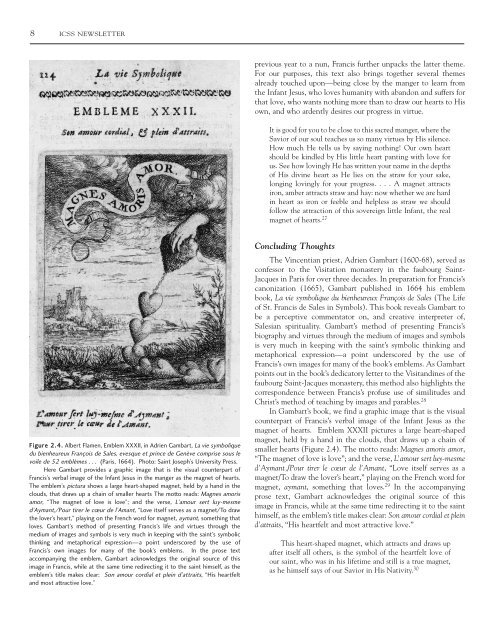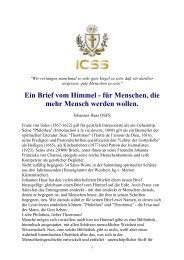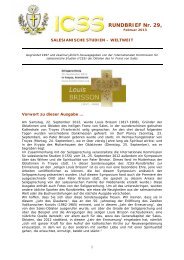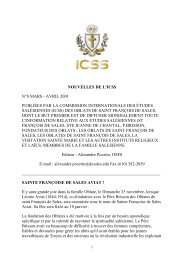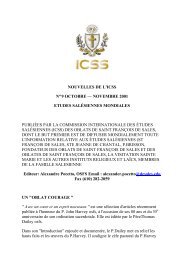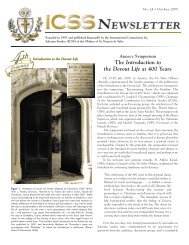St. Francis de Sales's Spirituality of the Crèche - Franz von Sales
St. Francis de Sales's Spirituality of the Crèche - Franz von Sales
St. Francis de Sales's Spirituality of the Crèche - Franz von Sales
Create successful ePaper yourself
Turn your PDF publications into a flip-book with our unique Google optimized e-Paper software.
8 ICSS NEWSLETTER<br />
Figure 2.4. Albert Flamen, Emblem XXXII, in Adrien Gambart, La vie symbolique<br />
du bienheureux François <strong>de</strong> <strong>Sales</strong>, evesque et prince <strong>de</strong> Genève comprise sous le<br />
voile <strong>de</strong> 52 emblèmes . . . (Paris, 1664). Photo: Saint Joseph’s University Press.<br />
Here Gambart provi<strong>de</strong>s a graphic image that is <strong>the</strong> visual counterpart <strong>of</strong><br />
<strong>Francis</strong>’s verbal image <strong>of</strong> <strong>the</strong> Infant Jesus in <strong>the</strong> manger as <strong>the</strong> magnet <strong>of</strong> hearts.<br />
The emblem’s pictura shows a large heart-shaped magnet, held by a hand in <strong>the</strong><br />
clouds, that draws up a chain <strong>of</strong> smaller hearts The motto reads: Magnes amoris<br />
amor, “The magnet <strong>of</strong> love is love”; and <strong>the</strong> verse, L’amour sert luy-mesme<br />
d’Aymant,/Pour tirer le cœur <strong>de</strong> l’Amant, “Love itself serves as a magnet/To draw<br />
<strong>the</strong> lover’s heart,” playing on <strong>the</strong> French word for magnet, aymant, something that<br />
loves. Gambart’s method <strong>of</strong> presenting <strong>Francis</strong>’s life and virtues through <strong>the</strong><br />
medium <strong>of</strong> images and symbols is very much in keeping with <strong>the</strong> saint’s symbolic<br />
thinking and metaphorical expression—a point un<strong>de</strong>rscored by <strong>the</strong> use <strong>of</strong><br />
<strong>Francis</strong>’s own images for many <strong>of</strong> <strong>the</strong> book’s emblems. In <strong>the</strong> prose text<br />
accompanying <strong>the</strong> emblem, Gambart acknowledges <strong>the</strong> original source <strong>of</strong> this<br />
image in <strong>Francis</strong>, while at <strong>the</strong> same time redirecting it to <strong>the</strong> saint himself, as <strong>the</strong><br />
emblem’s title makes clear: Son amour cordial et plein d’attraits, “His heartfelt<br />
and most attractive love.”<br />
previous year to a nun, <strong>Francis</strong> fur<strong>the</strong>r unpacks <strong>the</strong> latter <strong>the</strong>me.<br />
For our purposes, this text also brings toge<strong>the</strong>r several <strong>the</strong>mes<br />
already touched upon—being close by <strong>the</strong> manger to learn from<br />
<strong>the</strong> Infant Jesus, who loves humanity with abandon and suffers for<br />
that love, who wants nothing more than to draw our hearts to His<br />
own, and who ar<strong>de</strong>ntly <strong>de</strong>sires our progress in virtue.<br />
It is good for you to be close to this sacred manger, where <strong>the</strong><br />
Savior <strong>of</strong> our soul teaches us so many virtues by His silence.<br />
How much He tells us by saying nothing! Our own heart<br />
should be kindled by His little heart panting with love for<br />
us. See how lovingly He has written your name in <strong>the</strong> <strong>de</strong>pths<br />
<strong>of</strong> His divine heart as He lies on <strong>the</strong> straw for your sake,<br />
longing lovingly for your progress. . . . A magnet attracts<br />
iron, amber attracts straw and hay: now whe<strong>the</strong>r we are hard<br />
in heart as iron or feeble and helpless as straw we should<br />
follow <strong>the</strong> attraction <strong>of</strong> this sovereign little Infant, <strong>the</strong> real<br />
magnet <strong>of</strong> hearts. 27<br />
Concluding Thoughts<br />
The Vincentian priest, Adrien Gambart (1600-68), served as<br />
confessor to <strong>the</strong> Visitation monastery in <strong>the</strong> faubourg Saint-<br />
Jacques in Paris for over three <strong>de</strong>ca<strong>de</strong>s. In preparation for <strong>Francis</strong>’s<br />
canonization (1665), Gambart published in 1664 his emblem<br />
book, La vie symbolique du bienheureux François <strong>de</strong> <strong>Sales</strong> (The Life<br />
<strong>of</strong> <strong>St</strong>. <strong>Francis</strong> <strong>de</strong> <strong>Sales</strong> in Symbols). This book reveals Gambart to<br />
be a perceptive commentator on, and creative interpreter <strong>of</strong>,<br />
<strong>Sales</strong>ian spirituality. Gambart’s method <strong>of</strong> presenting <strong>Francis</strong>’s<br />
biography and virtues through <strong>the</strong> medium <strong>of</strong> images and symbols<br />
is very much in keeping with <strong>the</strong> saint’s symbolic thinking and<br />
metaphorical expression—a point un<strong>de</strong>rscored by <strong>the</strong> use <strong>of</strong><br />
<strong>Francis</strong>’s own images for many <strong>of</strong> <strong>the</strong> book’s emblems. As Gambart<br />
points out in <strong>the</strong> book’s <strong>de</strong>dicatory letter to <strong>the</strong> Visitandines <strong>of</strong> <strong>the</strong><br />
faubourg Saint-Jacques monastery, this method also highlights <strong>the</strong><br />
correspon<strong>de</strong>nce between <strong>Francis</strong>’s pr<strong>of</strong>use use <strong>of</strong> similitu<strong>de</strong>s and<br />
Christ’s method <strong>of</strong> teaching by images and parables. 28<br />
In Gambart’s book, we find a graphic image that is <strong>the</strong> visual<br />
counterpart <strong>of</strong> <strong>Francis</strong>’s verbal image <strong>of</strong> <strong>the</strong> Infant Jesus as <strong>the</strong><br />
magnet <strong>of</strong> hearts. Emblem XXXII pictures a large heart-shaped<br />
magnet, held by a hand in <strong>the</strong> clouds, that draws up a chain <strong>of</strong><br />
smaller hearts (Figure 2.4). The motto reads: Magnes amoris amor,<br />
“The magnet <strong>of</strong> love is love”; and <strong>the</strong> verse, L’amour sert luy-mesme<br />
d’Aymant,/Pour tirer le cœur <strong>de</strong> l’Amant, “Love itself serves as a<br />
magnet/To draw <strong>the</strong> lover’s heart,” playing on <strong>the</strong> French word for<br />
magnet, aymant, something that loves. 29 In <strong>the</strong> accompanying<br />
prose text, Gambart acknowledges <strong>the</strong> original source <strong>of</strong> this<br />
image in <strong>Francis</strong>, while at <strong>the</strong> same time redirecting it to <strong>the</strong> saint<br />
himself, as <strong>the</strong> emblem’s title makes clear: Son amour cordial et plein<br />
d’attraits, “His heartfelt and most attractive love.”<br />
This heart-shaped magnet, which attracts and draws up<br />
after itself all o<strong>the</strong>rs, is <strong>the</strong> symbol <strong>of</strong> <strong>the</strong> heartfelt love <strong>of</strong><br />
our saint, who was in his lifetime and still is a true magnet,<br />
as he himself says <strong>of</strong> our Savior in His Nativity. 30


